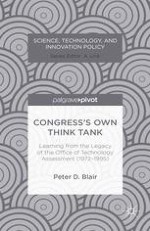2013 | Buch
Congress’s Own Think Tank: Learning from the Legacy of the Office of Technology Assessment (1972–1995)
Learning from the Legacy of the Office of Technology Assessment (1972–1995)
verfasst von: Peter D. Blair
Verlag: Palgrave Macmillan US
Buchreihe : Science, Technology, and Innovation Policy
